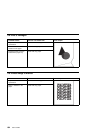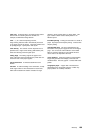characters per inch. Uniformly spaced fonts are
measured in pitches. Contrast with point.
point. A unit of measurement for describing type sizes.
There are 12 points to a pica, about 72 points to an
inch.
point of origin. The location of the first print position
on a logical page. The point of origin is usually stated in
terms of X and Y coordinates. The point of origin used
by a printer can be affected by factors such as printable
area and forms orientation.
portrait orientation. Pertaining to a display or hard
copy with greater height than width. Contrast with
landscape orientation.
PostScript. (1) A page description language with
interactive graphics capabilities that was developed by
Adobe Systems, Inc. (2) An interpretive programming
language that describes the appearance of text,
graphical shapes, and sampled images on a printed
page by defining a print file format that is the interface
between document composition applications and raster
printing devices.
preprinted form. A sheet of forms containing a
preprinted design of constant data with which variable
data can be combined. See also forms.
Print-Error Marker (PEM). Small, black, rectangular
marks that indicate incorrectly placed data in the valid
printable area.
print position. The physical positions of the characters
constituting a print line relative to the form.
print quality. The quality of printed output relative to
existing standards and in comparison with jobs printed
earlier.
print surface. The side of a form that receives the
printed image.
raster. (1) In computer graphics, a predetermined
pattern of lines that provides uniform coverage of a
display space. (2) The coordinate grid that divides the
display area of a display device. (3) In the Network
Printer 12, an on/off pattern of electrostatic images
produced by the laser print head under control of the
character generator.
raster font. A font in which each character is defined
by a raster bitmap.
raster pattern. A series of picture elements (pels)
arranged in scan lines to form an image.
raster scan. A technique of generating or recording the
elements of an image by a line-by-line sweep across the
entire output medium.
resident font. Those font data sets that are resident
within the printer. They usually reside on the printer disk
media (diskette or hard disk). These font sets are
usually commonly used fonts. Having them resident
reduces font load time. These fonts may also be used
during offline testing of the printer.
scalable font. A font whose graphic characters are
represented by mathematical equations and can be
sized to different heights.
SCS. See SNA character string.
SIMM. Single inline memory module.
simplex printing. Printing on one side of a sheet of
paper. Contrast with duplex printing.
SNA character string. In SNA, a character string
composed of EBCDIC controls, optionally intermixed with
end-user data, that is carried within a request/response
unit.
skew. Refers to the paper going through the paper
path at a slight angle. This will cause the printing lines
to not be aligned properly.
stacker. A device used to hold paper or forms that
have been printed; the output device of a printer.
storage. (1) The retention of data in a storage device.
(2) In word processing, a unit into which recorded text
can be entered, in which it can be retained and
processed, and from which it can be retrieved. (3) A
device, or part of a device, that can retain data.
symbol set. In PCL5e, a particular assignment of
hexadecimal identifiers to graphic characters.
text orientation. The position of text as a combination
of print direction and baseline direction. See also
orientation.
throughput. A measure of the amount of work
performed by the printer over a period of time, for
example, number of jobs per day.
188 User’s Guide


















